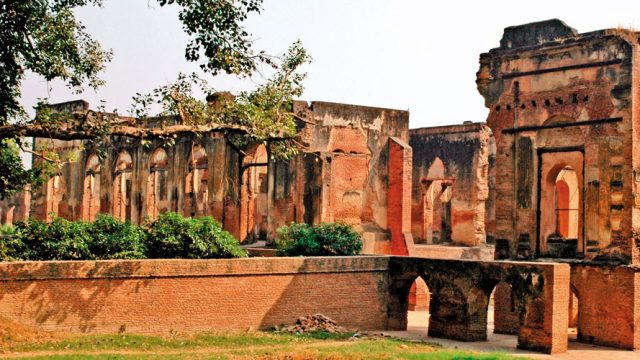The year is 1857. There is darkness all around. The silence is deafening, after the torturous sounds of shelling, screaming and wailing. This is the silence of the soul. A month has gone by like this and so have the men with whom he had shared food, shelter, laughter and sorrows. Of the 3,000 people seeking shelter about half are still alive; the rest surrounded him in the form of mangled bodies and decomposing corpses. How he wants everything to end. How he wants some food and water. How he hopes for a white-light saviour.
Sitting under a tamarind tree soaking up the winter sun of January in the manicured lawns of the British Residency in Lucknow, this story plays itself out cinematically in my head. A figment of my overwrought imagination, yes, but surely not so far from the truth of what might have ensued during the siege of 1857.
Over the years, Lucknow has earned a special reputation, for being at the intersection of cultures and laid-back grandeur. But this glorious history is stained red. Celebrated across regions for nawab, adaab (respect), kebab and shabab (beauty), surprisingly few know of the dark deeds hidden behind the ruins of the colonial walls of the British Residency, located in the heart of the city.
The construction of the Residency began in 1775, after the capital of Awadh was shifted to Lucknow from Faizabad. Built over 25 years, its original purpose was to accommodate the British resident and his staff. The construction of the monument was started by Nawab Asafuddaula and was completed by Nawab Saadat Ali Khan, both rulers eager to have amicable relations with the British. As time passed, more buildings were added to the complex and soon the Residency occupied the highest elevation and became an imposing landmark in the city.
Of all the military engagements in the Revolt of 1857, Lucknow played a central part—the siege at the Residency proved to be the longest and most intense. Continuing for an estimated 90 days, more than 2,000 people living inside the complex died and it took the British armed forces to finally crush the revolt.
Now protected by the Archaeological Survey of India, the complex is an important historical landmark of the city. While the Bailey Guard Gate still stands tall and imposing, the buildings and structures inside are heavily damaged. Some were razed to the ground due to the shelling.

The 1857 Memorial Museum presents a visual account of the revolt. Featuring lithographs, photographs, paintings, documents and preserved objects such as swords, guns and cannons, the exhibit depicts the significant events as well as portraits of local heroes. The museum also exhibits a scale model of the original buildings. The basement of the building is where the besieged colonisers attempted to take refuge from the mutineers.
Away from the chaos of the beggars and ice cream-wallas on the main road, entering from the Bailey Guard Gate, the atmosphere of the place is overpowering. Spread across wide expanses of well-kept lawns, the Treasury House and Dr Fayrer’s House are the first two structures that present themselves on either side of a red path that winds to more such monumental ruins ahead.
The buildings, pockmarked by bullets and cannon balls, present a conglomeration of architectural styles and influencing cultures. While retaining the Nawabi style of architecture, they also display British classical styles. Since the initial structures were constructed by the Nawabs, they feature arches and a hint of a labyrinth as seen in the city’s other famous landmark, the Bhulbhulaiya of the Bada Imambara. However, an exploration of later buildings reveals Gothic elements characterised by pointed arches. Corridors that stand without roofs reflect perfect symmetry, rib vaults and flying buttresses.
Next to Dr Fayrer’s house is Begum Kothi, which served as the residential quarters of the Begum of Nasir-ud-Din Haidar. Behind it lies the mosque and imambara where she used to worship. A final stop must be at the cemetery, which tells its tales of sorrow and bereavement. Of all the headstones, the most visited is of Sir Henry Lawrence. When the siege began, the British were led by Lawrence but he was killed in a few days. His tombstone honours his last wish: that it read, “Here lies Henry Lawrence, who tried to do his duty. May Lord have mercy on his soul.”
For a place that echoes the horrors of a great mutiny, the Residency is today a serene place with beautiful old trees, glorious gardens and crumbling ruins. The red walls enclose a favourite place for youngsters to take their endless selfies and for couples to enjoy an undisturbed cuddle. Occasionally, one can even see a pre-wedding photo-shoot in progress. Lucknow’s Residency is an island of history, offering modern-day tranquillity against a backdrop of violence.




